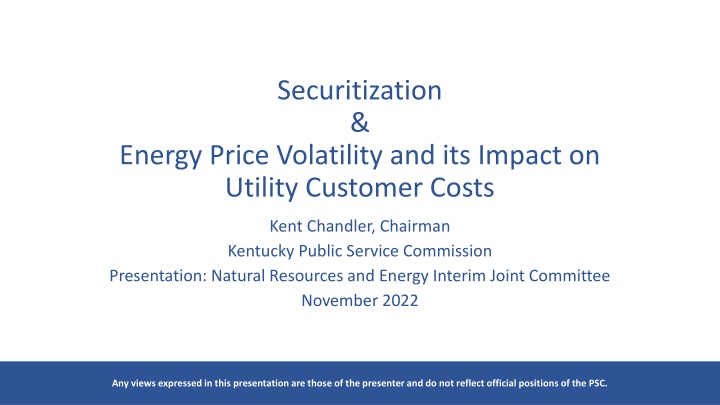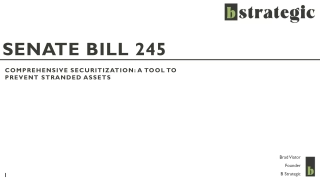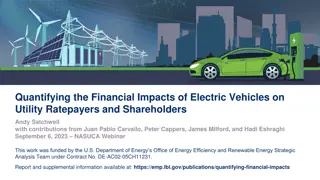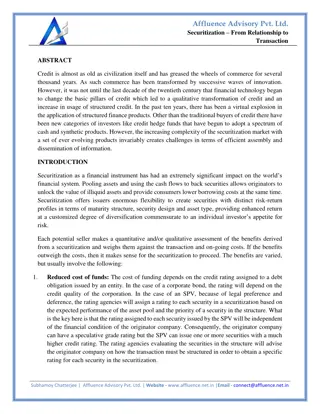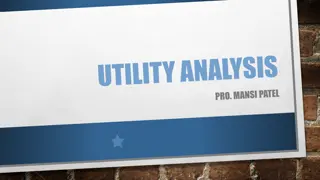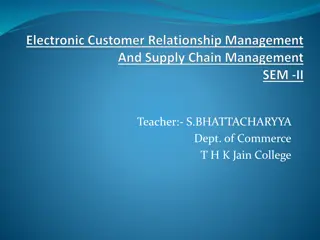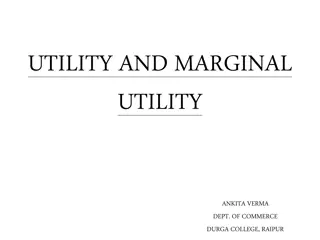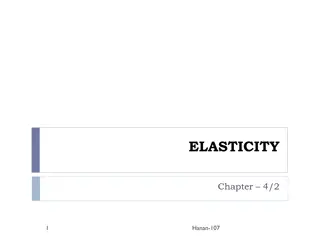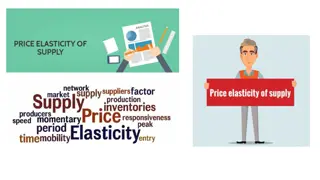Securitization & Energy Price Volatility Impact on Utility Customer Costs
This presentation by Kent Chandler, Chairman of Kentucky Public Service Commission, explores the impact of securitization on utility customer costs amidst energy price volatility. The views expressed are those of the presenter and not official positions of the PSC.
Download Presentation

Please find below an Image/Link to download the presentation.
The content on the website is provided AS IS for your information and personal use only. It may not be sold, licensed, or shared on other websites without obtaining consent from the author.If you encounter any issues during the download, it is possible that the publisher has removed the file from their server.
You are allowed to download the files provided on this website for personal or commercial use, subject to the condition that they are used lawfully. All files are the property of their respective owners.
The content on the website is provided AS IS for your information and personal use only. It may not be sold, licensed, or shared on other websites without obtaining consent from the author.
E N D
Presentation Transcript
Securitization & Energy Price Volatility and its Impact on Utility Customer Costs Kent Chandler, Chairman Kentucky Public Service Commission Presentation: Natural Resources and Energy Interim Joint Committee November 2022 Any views expressed in this presentation are those of the presenter and do not reflect official positions of the PSC.
PSC Mission To foster the provision of safe and reliable service at a reasonable price to the customers of jurisdictional utilities while providing for the financial stability of those utilities by setting fair and just rates, and supporting their operational competence by overseeing regulated activities. 2
Public Service Commission Independent Regulatory Agency Three-member Commission Quasi-judicial function Regulates rates and service provided by jurisdictional utilities: 1,100 jurisdictional utilities Water and sewer utilities (small systems comprise the bulk of regulated utilities) Natural gas distribution systems and intrastate pipelines Electric utilities (investor-owned and jurisdictional cooperatives) Telecommunications (small number) Does not regulate municipal utilities except for gas pipeline safety. Does not regulate cooperatives served by TVA. 3
ReliabilityService and Rates Since 1934, the primary statutory directive of utility regulation in Kentucky revolves around: Rates Fair, just and reasonable Service Adequate, efficient and reasonable Most everything in retail utility regulation comes back to one or both of these principles. 4
Ratemaking Utilities in Kentucky are not competitive businesses, but instead have their rates and service regulated by the PSC Historically, there was a concern around the duplication of the same service, leading to the inefficient investment of capital Electric Utilities, for instance, were provided defined service territories: They have an obligation to serve everyone who demands service in that territory A state granted monopoly creates two primary problems: risk of poor service, and monopoly profits in excess of costs Solution: regulate the utility s rates and service 5
Ratemaking, continued. The rate regulation of monopoly, investor-owned utilities is a function of costs Of course, in the idealized version of competition, and in particular a perfect market, in the short run prices will reflect the marginal cost of a particular product. The introduction of monopolies leads to an expectation that the firm will charge prices well in excess of costs, leading to the sale of less goods, and resulting in deadweight loss Under this scenario, the producer has more surplus, consumers have less surplus and there is also a complete loss of potential gains that neither accrue to the producer or consumer; that is deadweight loss. 6
Ratemaking, continued. Deadweight loss 7
Ratemaking, continued. Again the rate regulation of monopoly, investor-owned utilities is a function of costs Since we have concerns about the prices a monopoly would charge, particularly charging rates in excess of costs, rates are created based on the costs incurred or expected to be incurred by a utility The first step in ratemaking is to determine all of the costs a utility incurred or expects to incur in a year that are deemed to be recoverable from customers This includes operations and maintenance expenses, the investments made by the utility, and a return on the capital reflected by the investments. 8
Ratemaking, continued. This determination of the utility s annual expenses that are recoverable from customers is called the revenue requirement, and is calculated below Revenue Requirement= O & M expenses + (original investments- amount of investments already recovered)* Rate of return O&M expenses includes repairs, taxes, depreciation expense, labor, fuel, insurance, etc. Original Investments is the gross value of the utility s property (costs that are depreciated) Amount of investments already recovered is referred to as accumulated depreciation Rate of Return is the cost of the debt and equity capital underpinning the investments 9
Ratemaking, continued. The rate of return is reflective of the cost and relative type of capital used to fund investments. Debt capital is less expensive than equity capital because of the rights and risk of each type of capital If 50% of investments were funded by debt, provided at a cost of 4%, and the other 50% was funded by equity investments at a cost of 10%, the cost of capital is: (.5*.04)+(.5*.1)=.07 or 7% If you originally invested 100 dollars, and recovered 50 of it over the last 10 years, in this year your return on investment would be: (100-50)*.7= $3.50 However, $3.50 isn t profit, because lenders will demand their payment on the debt. $1, or ($50/2)*4% of the $3.50 will pay the cost of the debt The profit of the utility in this year would be $2.50 10
Ratemaking, continued. Utilities make more profit the more they invest This is assuming the cost of equity capital is constant The PSC determines the cost of equity capital in rate cases, to ensure that the utility shareholders rate of return on their equity investments are commiserate with the risk experienced by the utility This should create a natural equilibrium over time If the cost of equity capital is set too low, you may have underinvestment in the utility (not necessarily by the utility) If the cost of equity capital is set too high, you may see investors flock to invest in the utility 11
Securitization Is the process of financing cash flows from a specific asset or pool of assets, and issuing claims on these assets, through the issuance of asset-backed securities.1 More simply, securitization is a process set out by a state statute that can permit customers of a utility to effectively buy an asset from a utility using money provided by bonds financed by lenders. Effectively, since the utility earns an equity and debt return on their own investments, replacing that investment with only debt capital reduces the financing costs of that asset. The bonds used to buy out the utility are sometimes referred to as ratepayer-backed bonds because they are financed on the premise that a utility s customers, pursuant to a statute, have guaranteed the repayment of the bond according to predetermined schedules. 12
Securitization - Simple scenario Scenario: A utility has a powerplant/generator that has $200M left of investment that the utility has not recovered yet Recent federal environmental laws require the generator to either upgrade that generator to come into compliance with law ABC, or retire by 2028 Upgrading the generator to comply with the law would cost $500M, while retiring it and replacing it with the necessary replacement generation would cost only $175M, and the replacement generation would have the same operating costs as the current generation and the same expected useful life as the current facility after it would be retrofitted. The utility determines the least cost, most reasonable option is to retire the current generation and replace it with the new one 13
Securitization - Simple scenario Scenario, cont.: The utility proposes to a PSC to build the new generator as the least cost, most reasonable option, given the need for generation after its retirement of the old generator. At the same time, the utility requests PSC approval for the deferral and subsequent recovery of the remaining value of the retiring power plant as a regulatory asset. A regulatory asset is a paper asset that reflects a cost that otherwise would have to be incurred in a single year, like an expense, but is treated like an asset and is recovered over a number of years. Generally, regulatory assets earn a return like other investments, including a return on the equity capital portion 14
Securitization - Simple scenario Scenario, cont.: Deferral accounting in this situation makes economic sense. Without the regulatory asset, accounting rules would require the utility to expense the remaining value of the retiring generator($200M). The retirement and replacement of the generator is better for customers ($500M v $175M). If the utility didn t expect to receive approval for the regulatory asset, they would be incentivized to find ways to go with the retrofit, so that it recovered all its investment, but doing so would be bad for customers, to the tune of $325M, plus a profit on that extra $$$. 15
Securitization - Simple scenario Scenario, cont.: Assuming the PSC agrees the replacement generator is the least cost, most reasonable way to serve customers, here is where the scenario stands: Old power plant retired Value of old plant is a regulatory asset of $200M New generator at a value of $175M Utility earning a return, and charging customers that return, on $375M Securitization provides an opportunity to replace the $200M of the utility s investment in the regulatory asset with $200M financed by ratepayer-back bonds 16
Securitization - Simple scenario process Assuming the state has a statute permitting securitization, the ordinary process may be the following: Utility applies to the PSC for an order approving it to market bonds, impose, and collect charges from customers to pay the debt and to create a security interest in the underlying property. Application may include: Description of the costs represented by the regulatory asset Testimony describing the proposal Proposed transaction, including customer impact, savings, etc. Estimated cost of financing Proposal for nonbypassable customer charges to recover costs 17
Securitization - Simple scenario process PSC reviews the application to make sure the proposal is good for customers and in the public interest, including: A net present value benefit to customers over the alternative or status quo No unnecessary impairment of the utility s financial health The level and allocation amongst customers and customer classes of nonbypassable charges PSC may employ professionals, either financial or legal, to help assist in considering the application. Those costs would be included in benefit calculations and recovered as part of the securitized costs 18
Securitization - Simple scenario process PSC order approving the proposal may include Finding that securitization is a net benefit to customers Financing details, such as amount of the bonds, estimate of financing costs, length of the bonds, and what the proceeds should be explicitly used for Explanation of the mechanism for repayment of the bonds, including periodic updates to the nonbypassable charge to customers Requirement that customers pay until bond is paid Authorization for the utility to market the bonds (if utility is designated) Any other rules on the utility related to these charges or the bonds Finally, a term that the order stays in effect and can t be amended, modified or revoked, and that the securitized property interest can t be impaired 19
Securitization- Why? Some costs are nonrecurring, one-time, extreme, or are otherwise not ordinary property that makes utility financing of those costs expensive for customers and unnecessarily burdensome for a utility Debt costs less than equity capital Although the principal amount is the same, the reduction in the interest rate, coupled with the time value of money, can lead to significant customer savings compared to the status quo Utilities make investments in assets for the public benefit; they are not financing entities. Having them hold investments and receive a return on paper assets may not be the best use of their limited capital Securitization allows the utility to get out of investing in a paper asset, and put that capital to use, likely to invest in the assets to replace whatever the regulatory asset is related to (like the replacement generator in the scenario) Reduce the costs to customers of decisions or outcomes beyond most any stakeholder s control 20
Securitization Facts About half of states have legislation on the books allowing securitization Some are more prescriptive than others Some permit different types of bond marketing (utility v. state bonding authority) Different states allow securitization to apply to certain types of assets or costs, while some have complicated criteria that have to be met in an application: Retired generation Extreme fuel costs (winter storm Uri) Wildfire costs Extreme storm damage, such as hurricanes Debt is not backed by full faith and credit of the state- They are the obligation of the captive ratepayers As of May 2022, $62 billion of utility securitization bonds nationwide have been issued by electric utilities, ranging from $22M to $4B issuances 21
Securitization Need for statute Securitization works only because of the low-cost debt financing that replaces the combo debt and equity financing providing by the utility The reason that bondholders are willing to finance these ratepayer-back bonds that are not part of utility debt, is because of the strict language of statutes, PSC orders, security interest in the property, nonbypassable charges and other characteristics that ensure timely repayment of the debt. The ability to segregate the collateral in a bankruptcy-remote [special purpose entity] and the ability to make periodic adjustments to the Securitization Charges are critical to the rating agencies analysis to reach the highest possible rating category (AAA). 3 22
Energy Market Trends: Implications on Utility Regulation Current and emerging trends make each of these more complex relative to prior decades: Fuel Adjustment Clause( FAC ) (807 KAR 5:056) Integrated Resource Planning (807 KAR 5:058) Gas Cost Adjustments Certificate of Public Convenience and Necessity (KRS 278.020(1)) 23
Fuel Adjustment Clause (FAC) The FAC regulation has been in effect for 40 years. The FAC regulation allows jurisdictional utilities to reflect, through a line item on customers bills, the incremental or decremental cost of purchased power and/or fuel. Expenses incurred in a particular month appear in a subsequent month. Fuel costs make up a significant portion of the cost of providing electricity. For instance, in 2021, Kentucky Utilities, the largest utility in the Commonwealth, had approximately $1.64B in retail sales, while of that, $500M, or almost 1/3 of sales, was a pass through of fuel costs. As we ve seen in the last year, fuel expenses can fluctuate widely. Compared to the past 10 years, all electric and natural gas utilities have experienced higher fuel and purchased power costs in recent months. 24
Fuel Adjustment Clause- How it works The incremental or decremental amount of the FAC is set against a baseline fuel cost that is otherwise recovered through base rates- e.g. the customer and kWh charge. If the utility s fuel costs in a given month are above the baseline, the FAC appears as a per-kilowatt-hour surcharge (increment). If fuel costs fall below the baseline, the FAC appears as a per-kilowatt-hour credit (decrement). Utilities are required to fully document all of their fuel costs, including submitting fuel purchase contracts, fuel bid sheets and other materials to the PSC. The PSC reviews a utility s FAC filings, including conducting a detailed review every six months and then a final review, which occurs at two-year intervals. During its review, if the PSC determines costs to be unjustified due to improper calculation or application of the charge or improper fuel procurement practices, the PSC may disallow recovery of those costs and order a refund to customers. 25
Gas Cost Adjustments Tariff provisions that permit a gas distribution utility to pass through commodity cost changes Filed on a prospective basis quarterly Includes New gas costs Under or over recovery during last quarter Difference between actual and expected gas cost last quarter (if estimated) Provision for balancing adjustment 26
What are we seeing? Gas example- Gas Cost Adjustment Atmos General Sales Gas Cost Recovery Oct. 2022- $9.5833 per McF Oct. 2020- $3.9108 per McF Electric example AEP- Kentucky Power FAC Billed Rate per kWh Oct. 2022- $.04064 Oct. 2020- ($.00243) Fuel issues Coal Gas- electric coordination 27
Emerging TrendsGeneration Options. What is available? Wind Few places in Kentucky have adequate wind speeds and topography Solar Requires about 6-10 acres per MW, less reliability contribution in winter months Nuclear Currently unlikely, however emerging, advanced technologies could alter viability Coal New units unable to be built, primarily because of NSR requirements Natural Gas Often chosen by generation modeling as least-cost resource, but risks exist around ability to site infrastructure and actual useful life Energy Efficiency/Demand Side Management plenty of cost-effective amounts available, but inability to actually produce electricity Batteries limited duration (4 to 8 hours) and relatively expensive Hybrid Resources Promising, but relatively new Hydrogen Not yet proven to be cost-effective or readily available 28
Kentucky's Current Electricity Generation Profile 0.56 7 23.4 68.93 Natural Gas Coal Hydro RE 29
Endnotes 1, 3. Testimony of Eric Chang, Managing Director, Securitized Products Origination, Barclays Capital, Inc., IURC Cause No. 45722 30
